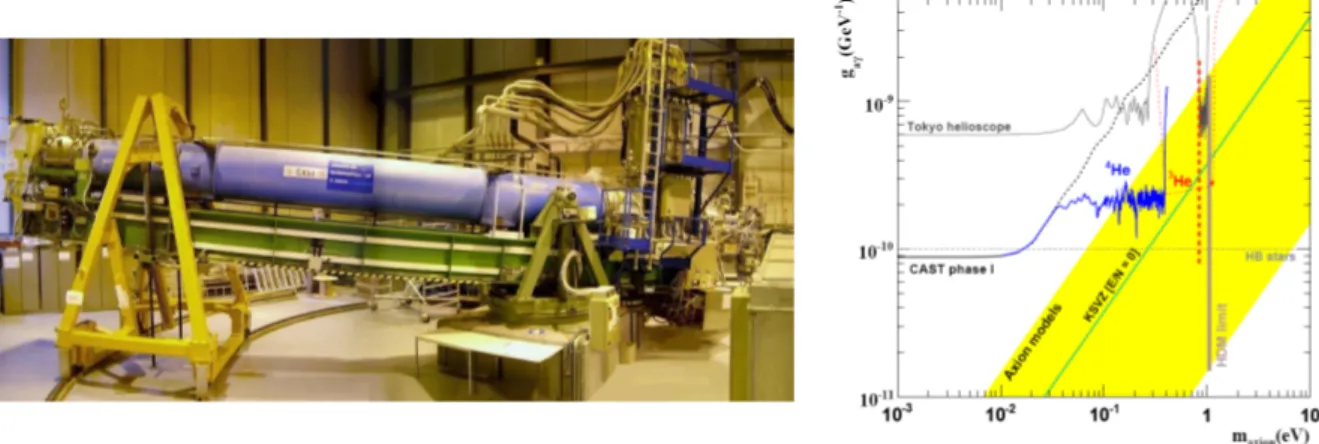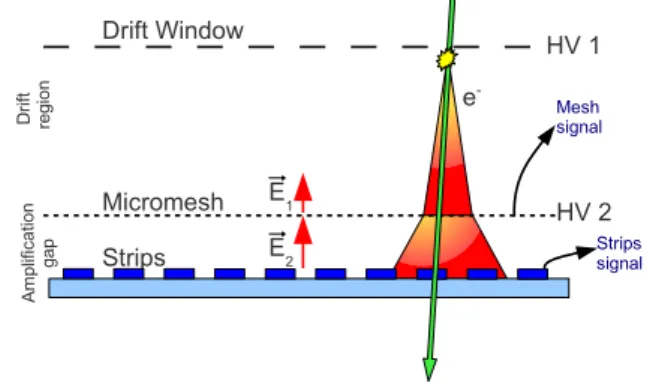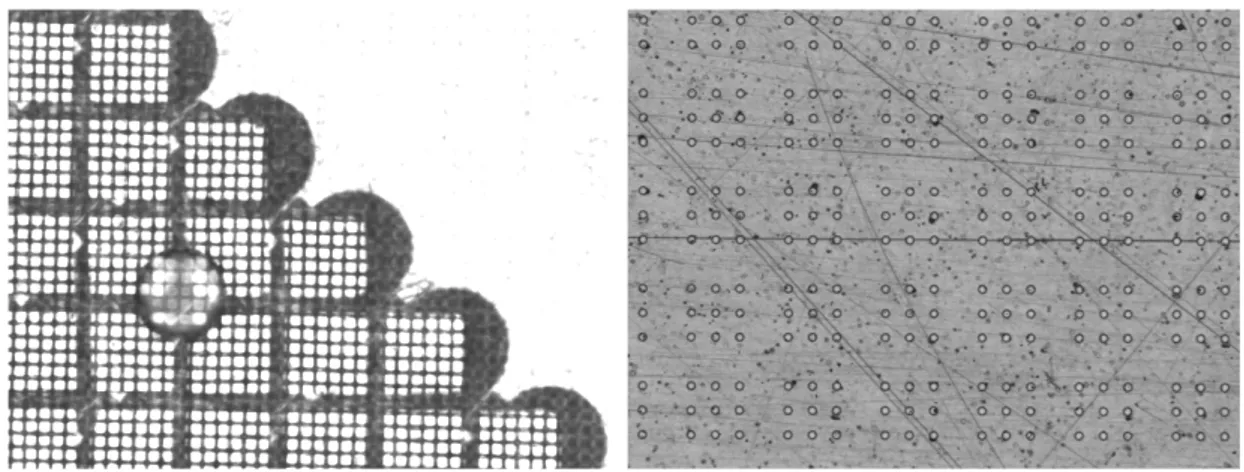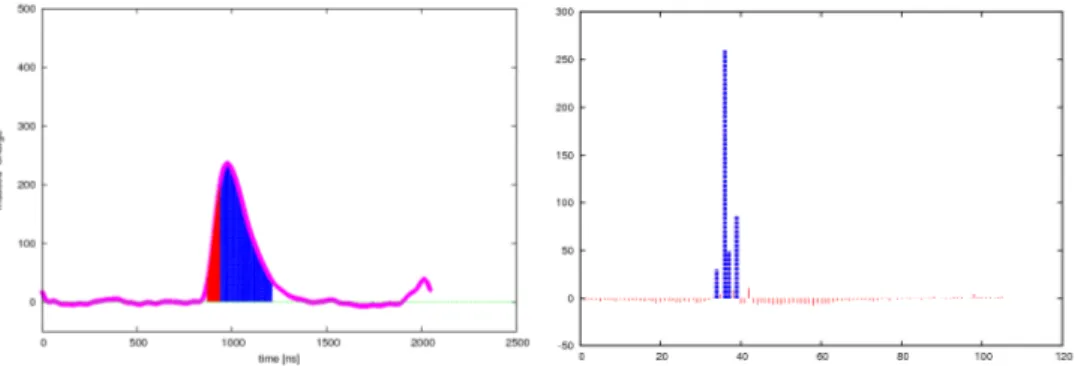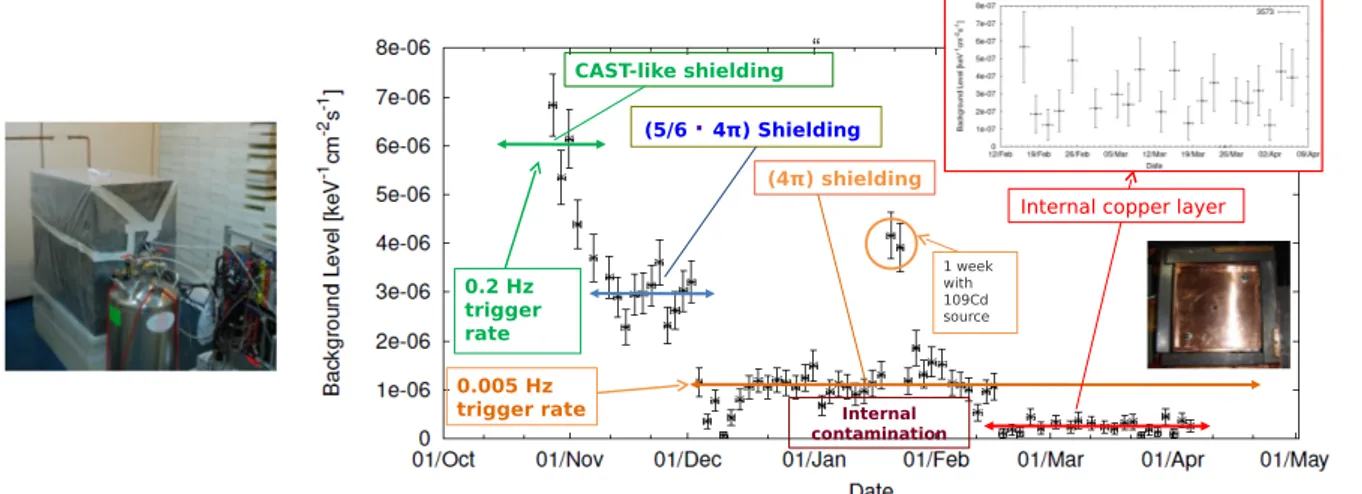This content has been downloaded from IOPscience. Please scroll down to see the full text.
Download details:
IP Address: 212.174.144.130
This content was downloaded on 16/12/2015 at 14:33
Please note that terms and conditions apply.
Performance of micromegas detectors in the CAST Experiment
View the table of contents for this issue, or go to the journal homepage for more 2012 J. Phys.: Conf. Ser. 347 012029
Performance of micromegas detectors in the CAST
Experiment
S C Yildiz1,2, S Aune3, T Dafni4, M Davenport5, G Fanourakis6, E
Ferrer-Ribas3, J Gal´an3, J A Garc´ıa4, A Gardikiotis7, J G Garza4, T
Geralis6, I Giomataris3, H G´omez4, F J Iguaz3, I G Irastorza4, T
Papaevangelou3, A Rodr´ıguez4, J Ruz4,5, A Tom´as4 and T
Vafeiadis5,7,8
1 Do˘gu¸s University, Istanbul, Turkey
2
Bo˘gazi¸ci University, Istanbul, Turkey
3 IRFU, Centre d ´Etudes de Saclay, CEA, France
4
Laboratorio de F´ısica Nuclear y Astropart´ıculas, Universidad de Zaragoza, Spain
5 CERN, European Organization for Particle Physics and Nuclear Research, Switzerland
6
Institute of Nuclear Physics, NCSR Demokritos, Greece
7 University of Patras, Greece
8
Aristotle University of Thessaloniki, Greece E-mail: cenk.yildiz@cern.ch
Abstract. CERN Axion Solar Telescope (CAST) experiment is searching for axions coming
from the Sun. Inside transverse magnetic fields, axions can be converted into X-rays, which can be detected by X-ray detectors. The expected energy of the signal in CAST is in the 1-10 keV range. Low noise and low background detectors are necessary to increase the sensitivity of the experiment. Micro Mesh Gaseous Structure (micromegas) detectors have been used in CAST since the beginning, providing good energy and spatial resolution for CAST’s needs. CAST has been intensely studying micromegas detectors to develop new technologies. Initially, CAST detectors consisted of a micromegas, a Time Projection Chamber (TPC) and a Charged Couple Device (CCD), however the improvements in micromegas technologies encouraged CAST to replace the TPC with 2 new micromegas detectors. In some periods during CAST run, ultra low background has been observed in one of the micromegas detectors and it is being investigated through simulations and laboratory tests carried out at Canfranc Underground Laboratory. If this low background is indeed not a systematic effect, it can open new possibilities on rare event searches.
1. CAST Experiment
CERN Axion Solar Telescope (CAST) has been running at CERN since 2003. CAST is searching for particles called axions. To solve the strong CP problem in the Standard Model, Peccei-Quinn mechanism is suggested, adding a global U(1) symmetry to the Standard Model. Axions arise from the breaking of this symmetry. Through Primakoff effect, axions can be converted into photons and vice versa in transverse magnetic and electric fields. The Sun is a good source for axions. The photons created in the core of the Sun can be converted into axions in the high electric fields of the solar plasma and travel to the Earth without interacting with ordinary matter. If one can create a high transverse magnetic field at the Earth, axions can be converted
back into photons and detected. The spectrum of photons coming from the hot core of the Sun is in the x-ray region, thus x-ray detectors should be used [1, 2].
CAST is using an LHC prototype dipole magnet, which is mounted on a pivot that can
move ±40◦ horizontally, ±8◦ vertically to track the Sun for 1.5 hours both during sunset and
sunrise. CAST has not yet discovered axions, but has been putting the best limits in the
parameter space of axion mass and coupling constant for axion - photon interaction. Both for the discovery potential and better upper limits in coupling constant, sensitivity of CAST depends on several factors: strength and length of the magnetic field, exposure time, detector efficiency and detector background levels. Magnet parameters and exposure time are limited by physical properties and constraints of the magnet. Detector hardware efficiency is limited by the cross section of the gas and windows that are between the detector and vacuum system. Among these, only the detector background levels are improvable. Hence low background detectors are crucial for the results of the experiment.
CAST magnet has 2 sides: sunset(taking tracking data during sunsets), and sunrise(taking tracking data during sunrise). 4 detectors are mounted on ends of two magnet bores. Currently in the sunset side there are 2 micromegas, while sunrise side is operational with a micromegas and a CCD detector, which is coupled to an x-ray telescope. A picture of CAST magnet and the exclusion plot can be seen in Figure 1.
Figure 1. Left: CAST magnet, installed on a pivot. It can move vertically and horizontally to track the Sun every day. Right: Axion coupling constant exclusion plot. CAST has been putting strictest limits on the axion - photon coupling.
2. Micromegas Detector
Micromegas detector was invented in 1996 by Charpak and Giomataris [3]. It is a gaseous detector that has two regions, 3 different voltage levels and 2 readout levels (Figure 2). On the top, there is the drift window, which is the first high voltage level (around −600V). Below the drift window there is the drift gap filled with gas. When charged particles or photons pass through the chamber, primary electrons are created by excitation of this gas. After the drift gap there is micromesh, a transparent mesh, which is both the second high voltage level (around −300V) and first readout level. The primary electrons are accelerated with the electric field directed from mesh to drift and excite more gas atoms. Most of the electrons pass through the mesh. The region below the mesh is called the amplification gap. Electrons are multiplied in this region with higher electric fields and create a signal in the anode pads/strips which is the third voltage level (at ground level) and second readout level. They are placed a short distance
from the mesh (50-150 µm) and provide a 2-dimensional readout. The ions that are created in amplification gap drift back, and create a signal in the mesh.
Strips Micromesh HV 1 HV 2 e -E1 E2 D rif t re gi on A m pl ifi ca tio n ga p Mesh signal Strips signal Drift Window
Figure 2. Illustration of micromegas detector’s
working principle. Incoming particles excite
gas atoms, and the free electrons move to the readout layers with the help of the electric field, stripping more electrons from the gas.
2.1. Micromegas Technologies
In CAST, different micromegas technologies have been used since the beginning of data taking.
2.1.1. Conventional Micromegas In conventional micromegas, the strips and mesh are attached
to each other mechanically. It was the first model to be used at CAST. The limit in the achievable resolution and rejection power directed CAST to develop better technologies, in which mesh and strips can be attached more uniformly by advanced methods.
2.1.2. Bulk Micromegas Bulk micromegas was developed in 2005 and has been used in CAST
for many years [4]. The main difference from conventional micromegas is that the 2 readout levels are being manufactured together. The 30µm thick stainless steel mesh and the strips are attached together with pillars in between, using PCB technology. Bulk detectors can provide energy resolutions as good as 18% (FWHM at 5.96 keV).
2.1.3. Microbulk Micromegas Similar to bulk micromegas, mesh and strips are produced
together [4]. In microbulk detectors, 5µm copper mesh is used and it is produced together
with strips by photo-lithography technique. Mesh holes are aligned with the shape of the
readout pads/strips, and due to the advanced production technique, amplification gap is smaller. Microbulk detectors have achieved better energy resolution than bulk detectors, as good as 12% (FWHM at 5.96 keV). The differences between bulk and microbulk micromegas can be seen in Figure 3.
3. Micromegas Detectors in CAST
CAST experiment is one of the first experiments to use micromegas detectors and has many collaborating institutes, contributing to the development of micromegas technologies. Micromegas detectors are preferred for their ease of production, good background levels and stable behaviour.
3.1. Sunrise and Sunset Lines
CAST uses 3 micromegas detectors, 2 in the sunset line and 1 in the sunrise line. Each of the current micromegas has a readout plane consisting of 106 strips in both x and y directions,
Figure 3. Left: Bulk micromegas. The cylindrical pillars are placed between the mesh and readout pads. Right: Microbulk micromegas. Mesh holes are grouped in 9 and positioned exactly where the readout pads are.
In the sunrise line, there has always been a micromegas installed. All micromegas technologies were used, and currently a microbulk micromegas is installed. Sunrise line is operating with 97.7% Argon, 2.3% isobutan mixture at a pressure of 1.4 bar. It is shielded with lead, copper and polyethylene. In 2011, a special extra shielding was installed to cover the pipe near the detector (Figure 4).
Figure 4. From left to right, sunrise micromegas in different shielding setups. Left: The detector with the lead, cadmium and copper shielding. Middle: The detector with the addition of polyethylene shielding. Right: New shielding implemented in 2011 to block an important contribution of the background events that come from the pipes.
In the sunset line, a TPC covering both bores was operational until 2007. The performance that was shown by the micromegas detector encouraged the replacement of the TPC with 2
micromegas detectors. A compact design was implemented to have common shielding and
vacuum pipeline for both detectors (Figure 5). Initially, a bulk and a microbulk detector
was used and currently 2 microbulk detectors are installed. The shielding and grounding
improvements lowered the electronic noise levels well under the threshold, and enabled stable detector operation. Sunset detectors are operating with 98% Argon, 2% isobutan mixture at a pressure of 1.4 bar. The shielding is similar to sunrise detectors.
3.2. Data Acquisition System
CAST Micromegas has been using a data acquisition chain made of NIM and VME modules and software written in Labview [11]. For every event that passes a certain threshold, time
Figure 5. Left: Drawing of the sunset micromegas detectors, showing their common Faraday cage. Right: Sunset side of the magnet with the full shielding.
information of the mesh pulse, and integrated charge on each strip are recorded, giving a 2 dimensional charge distribution in the strips.
Figure 6. Left: Time evolution of the pulse. Right: Integrated charge on each strip for one direction of the readout.
3.3. Background Discrimination
There are two types of observables in micromegas detectors. Pulse observables like risetime, width and integral are extracted from the time evolution of the pulse. The strip observables like multiplicity, cluster size and sigma of the cluster charge are extracted from charge distribution in the x and y strips.
Characteristics of x-rays signatures are obtained from Fe55calibration, which is done at least
once a day. Calibrations prove the stability of the detectors (Figure 7) and show that x-rays are localized events (creating only one cluster in the strips) with narrow distributions. Using pulse and strip observables, a decision on recognizing an event to be an x-ray signal is made. There are two different approaches to event selection at CAST: multivariate analysis and sequential cut analysis.
In the multivariate analysis, few observables are used to create an n-dimensional hyper ellipsoid. Information of the ellipsoid is used to create a single variable, and each event is evaluated using this variable. This method takes the correlations between the variables into account. In sequential cut analysis, various cuts can be defined and applied one after another. Cuts can be intervals in one dimensional distributions, or regions in 2 dimensional parameter space of observables. Multivariate method is known to be better when the observables are
correlated, while sequential cuts give greater control in the selection process. Despite the
differences, both methods have similar rejection capability and 99.9% of the background events are rejected and a stable background evolution is obtained (Figure 8).
0 200 400 600 800 1000 1200 1400 1600 0 50 100 150 200 250 300 350 400 450 500 Counts Voltage [mV] (mesh) Detector: Sunset1 Run ID: 14290 Detector: Sunset1 Run ID: 14290 Detector: Sunset1
Run ID: 14290 CalibrationFit
11-May 28-May 15-Jun 02-Jul 20-Jul 06-Aug 0 100 200 300 400 Gain 0 20 40 60 80 Energy Resolution Gain Energy Resolution
Figure 7. Left: Calibration spectrum. Right: Stability of the gain and of the energy resolution in 2008.
05-May 28-May 21-Jun 14-Jul 06-Aug 29-Aug 21-Sep
Date 0.0E+00 1.0E-05 2.0E-05 3.0E-05 4.0E-05 5.0E-05 Ba ck gr ou nd le ve l ( cm − 2s − 1E − 1) Background Levels of SS2 - M6 Background Definition 0 1 2 3 4 5 6 7
Number of Counts in a Period 0.00 0.05 0.10 0.15 0.20 0.25
Poissonian Compatibility of 2008 Sunset Detector M6 Poissonian, µ=2.50 Bck Counts: 0.70 hours
Figure 8. Left: Stability of the estimated background level in year 2008 in Sunset detector 2. Right: Compatibility of observed counts in periods of 0.7 hours with Poissonian distribution.
3.4. Evolution of Micromegas Detectors in CAST
Since the beginning of CAST, several different micromegas detectors have been used. The first detectors were conventional micromegas and had a less complete shielding compared to current detectors. The improvements in shielding together with the invention of bulk and microbulk technologies enabled better stability and lower background levels throughout the years.
3.5. Ultra Low Background Periods
Nominal background levels are around 8·10−6keV−1cm−2s−1in CAST micromegas. However, in
sunrise micromegas, there were some periods when this level decreased to 1 · 10−7keV−1cm−2s−1
for a few days. In 2011, with the implementation of a new shielding, a longer ultra low
background period was registered. However, the phenomenon is not yet fully understood. It can either be a real drop in the background caused by radon abundance, or a systematic error that we have yet not been able to detect.
The simulations and laboratory controlled background tests that are underway will improve the understanding of the real potential of micromegas detectors and reasons behind ultra low background levels. CAST micromegas detectors are currently being tested at CEA Saclay in Paris and Canfranc Underground Laboratory in Zaragoza. Furthermore a CAST detector lab is being established at CERN, and will have advanced instrumentation to test micromegas detectors soon. If ultra low background is a real effect, its comprehension may help us develop detectors that will stably have ultra low levels.
4. Background Simulations
There are several possible sources of background events in CAST. Cosmic rays, external gamma radiation, radon contamination and internal radioactivity of the detectors are the most likely ones. CAST micromegas team has initiated background simulations to understand the nature of the background events. The complete geometry of the sunrise micromegas, the pipeline around
it and the shielding is implemented in Geant4 [12] (Figure 9). Using the environmental flux values measured at Canfranc with a Germanium detector, the response of the detectors are being simulated. Simulated and experimental data show a good agreement. The simulations so far show that most of the background of micromegas detectors are coming from the interaction of external gammas with material close to the detector (windows and pipeline). This information led to the implementation of the new shielding in sunrise micromegas in 2011.
Figure 9. Left: Geometry of the
gaseous micromegas chamber. Right: Implementation of the shielding in Geant4.
5. Background Tests
A CAST microbulk micromegas is installed in Canfranc Underground Laboratory, Huesca, Spain. The laboratory is at a depth of 2500 m.w.e (meters water equivalent), where the muon flux is 4 orders of magnitude lower than that at the surface, the environment is stable and the environmental gamma flux is well known. The tests at Canfranc aim to understand the limits of internal radioactivity of CAST detectors, and explore the effects of different shielding setups on them. The detector at Canfranc was tested in different setups, primarily a CAST-like shielding, after a half closed lead shielding, and finally a fully closed lead shielding. Later, another thin layer of copper was installed inside the shielding, to prevent an internal contamination due to
Fe55 source. With the CAST-like shielding although trigger rate was lower, background levels
were similar to CAST, showing that cosmic rays are well discriminated by the offline analysis. As more shielding was added, background levels dropped more. The studies show that, by blocking the radiation from outside of the detector totally, the background levels can be brought down to
be as low as 1.5 · 10−7keV−1cm−2s−1 (Figure 10). This can be considered as a first upper limit
for the internal radioactivity of the detectors, and confirm that detectors are built from quite pure materials [10].
Evolution of the background levels at CAST, and comparison with the levels obtained in Canfranc can be seen in Figure 11.
6. Conclusions
CAST is continuing its search for axions with 3 micromegas and 1 CCD detectors. Micromegas has become popular in rare event search experiments for their stability in the long run and capacity for low background levels. The improvements in the micromegas technologies, especially
the development of microbulk micromegas, made them even more valuable. The ultra low
background phenomenon that CAST has observed few times during the recent years is under investigation by simulations and laboratory tests. The goal of the CAST micromegas team is to use the experience gained from the CAST and other controlled tests to develop the next generation micromegas technology with lower background levels, and use it at the next generation axion helioscopes.
“ CAST-like shielding (5/6 ·4π) Shielding (4π) shielding 1 week with 109Cd source 0.005 Hz trigger rate 0.2 Hz trigger rate
Internal copper layer
Internal contamination
Figure 10. Left: 4π shielding with 20cm of lead. It shields the detector from most of the cosmic particles and environmental gammas. Right: Evolution of the background levels at the Canfranc Underground Laboratory. After the installation of the full shielding, levels dropped
to 1.5 · 10−7keV−1cm−2s−1. By adding a thin copper layer between the calibration source and
the detector window, the level dropped to its minimum. The effect of the copper layer reveals
that, an important contribution to the background was coming from contamination due the Fe55
source. “ Nominal values during data taking campaigns Shielded Micromegas (bulk and microbulk technology)
Full Shielding at Canfranc Underground Lab
Unshielded, conventional Micromegas technology
Figure 11. Evolution of CAST micromegas
background levels throughout the years. Each point represent nominal values during different periods by different detectors. The rightmost point shows the final result of Canfranc tests.
7. Acknowledgements
We acknowledge support from the Spanish Ministry of Science and Innovation (MICINN) under contract Ref. FPA2008-03456, as well the CPAN project Ref. CSD2007-00042 from the Consolider-Ingenio2010 program of the MICINN. We also acknowledge support from the European Commission under the European Research Council T-REX Starting Grant Ref. ERC-2009-StG-240054 of the IDEAS program of the 7th EU Framework Program, and Turkish Atomic Energy Authority (TAEK).
Finally we would like to acknowledge members of CAST experiment for their hard work, making CAST a pioneer in the search for axions.
References
[1] Zioutas K et al. 1999 A decomissioned LHC model magnet as an axion telescope Nucl. Instrum. Meth. Phys. Res. A 425, 480-9
[2] Arik E et al. 2009 Probing eV-scale axions with CAST J. Cosmol. Astropar. Phys. JCAP02(2009)008 [3] Giomataris Y, Rebourgeard P, Robert J P and Charpak G 1996 A high-granularity position-sensitive gaseous
detector for high particle-flux environments Nucl. Instrum. Methods Phys. Res. A 376, 29-35 [4] Giomataris Y et al. 2006 Micromegas in a bulk Nucl. Instrum. Methods Phys. Res. A 560 405-408
[5] Aune S et al. 2009 New Micromegas detectors in the CAST experiment Nucl. Instrum. Methods Phys. Res. A 604 15-19
[6] Tom´as A et al. 2011 The new micromegas X-ray detectors in CAST X-Ray Spectrometry 40 240-246
[7] Aune S et al. 2009 An ultra-low-background detector for axion searches J. Phys.: Conf. Ser. 179 012015 [8] Andriamonje S et al. 2010 Development and performance of Microbulk Micromegas detectors JINST 5 P02001
[9] Gal´an J et al. 2010 MICROMEGAS detectors in the CAST experiment JINST 5 P01009
[10] Cebrian S et al. 2011 Radiopurity of Micromegas readout planes Astropart. Phys. 34 345-359
[11] Geralis T, Fanourakis G, Giomataris Y and Zachariadou K 2003 The data acquisition of the Micromegas detector for the CAST experiment Nuclear Science Symp. Conf. Record (Portland) vol 5, 3455-3459 [12] Agostinelli S et al. 2003 Geant4 - a simulation toolkit Nucl. Instrum. Methods Phys. Res. A 506 250-303
